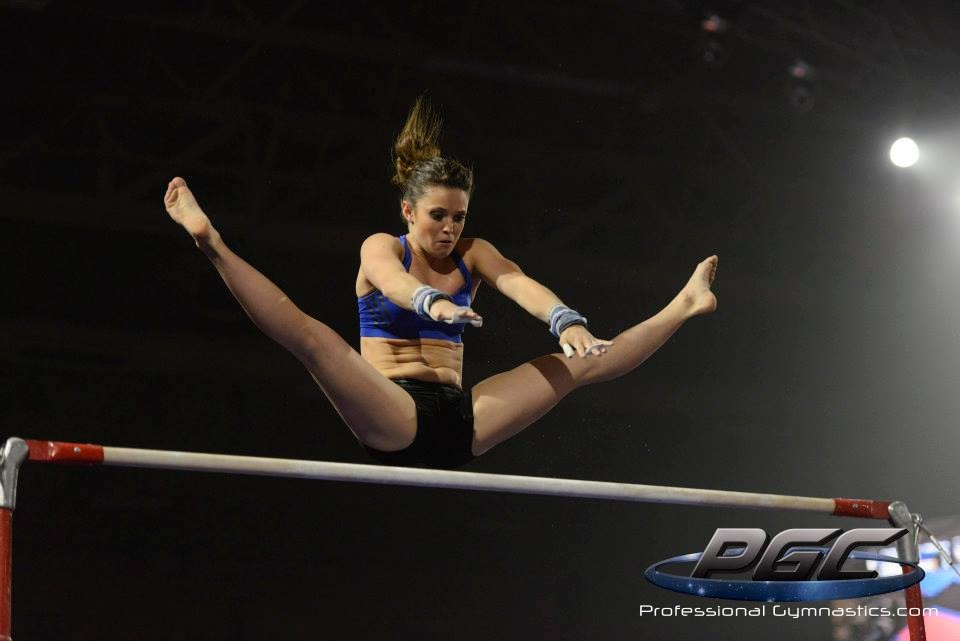Pro Gymnastics ChallengeJun 6, 2013 by Elizabeth Stranahan
Challenges for the Pro Gymnastics Challenge
Challenges for the Pro Gymnastics Challenge
Challenges for the Pro Gymnastics Challenge

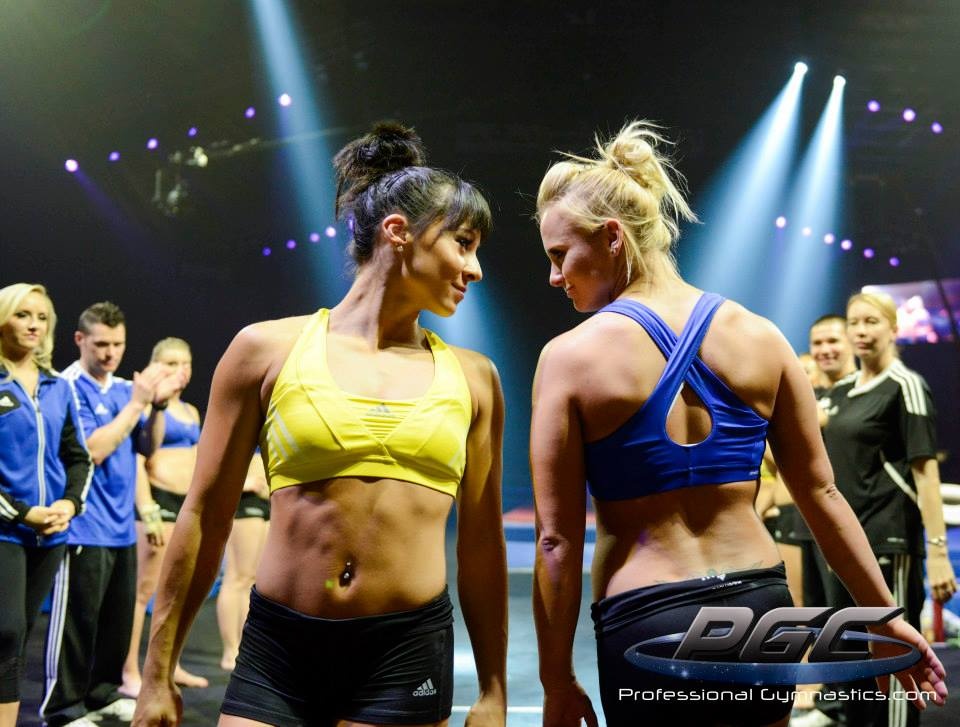
Team USA and Team World face off in the Pro Gymnastics Challege. Photo courtesy of PGC Facebook page.
On May 20th, IGC and ESPN2 unveiled the Professional Gymnastics Challenge (PGC), a two day competition aired over three days promising to revolutionize international gymnastics competition as we know it. The premise is a skill for skill challenge where the best American and international gymnasts duke it out for the bragging rights of who can perform the cleanest, highest, and most innovative gymnastics skills on the national stage.
As 2012 Olympian and PGC competitor Jake Dalton explained in his exclusive interview with Gymnastike earlier this summer, think, “like the X-Games, but for gymnastics.” The competition radically renovated the modern-day judging code in preference of a more audience-friendly system where celebrity judges—former 1996 Olympian Dominique Moceanu among them—simply vote on the gymnast they think gave a better performance in the face-off. In the case of a tie—and an obvious nod to keeping the audience involved—the studio audience, or arena audience in this case, can text in their vote establishing the “winner” and awarding the point. The first team to six points on each event wins the segment. The competition also revises the traditional four or six event competition as this is a co-ed sport, six new events are introduced to the arena: floor, vault, parallel bars and uneven bars, beam and rings, rope, audience all around, and high bar and single rail. The PGC also features some cushier mats than those seen at international competitions as the athletes are pulling out some difficult skills and, at times, attempting ones they’ve never practiced before. All in all the PGC makes some big promises in terms of offering a high intensity competition, but in a fun format that allows audiences to easily follow along.
As 2012 Olympian and PGC competitor Jake Dalton explained in his exclusive interview with Gymnastike earlier this summer, think, “like the X-Games, but for gymnastics.” The competition radically renovated the modern-day judging code in preference of a more audience-friendly system where celebrity judges—former 1996 Olympian Dominique Moceanu among them—simply vote on the gymnast they think gave a better performance in the face-off. In the case of a tie—and an obvious nod to keeping the audience involved—the studio audience, or arena audience in this case, can text in their vote establishing the “winner” and awarding the point. The first team to six points on each event wins the segment. The competition also revises the traditional four or six event competition as this is a co-ed sport, six new events are introduced to the arena: floor, vault, parallel bars and uneven bars, beam and rings, rope, audience all around, and high bar and single rail. The PGC also features some cushier mats than those seen at international competitions as the athletes are pulling out some difficult skills and, at times, attempting ones they’ve never practiced before. All in all the PGC makes some big promises in terms of offering a high intensity competition, but in a fun format that allows audiences to easily follow along.
At it’s core, the PGC holds up its end of the bargain providing an entertaining, interactive gymnastics experience that is easy for the casual gymnastics aficionado to understand, but rewarding for the gymnastics enthusiast to appreciate. The main draw of the PGC is the chance to see skills these competitors do not compete in regular season competition. Dalton explains there are many skills gymnasts play around with, but because of the rigid scoring format and high stakes at the elite level, many of these skills never see the international stage. The PGC provides an arena where gymnasts can pull out skills in training, skills too tiring to fit into full routines, and skills that the code just does not know what to do with. The range of choices provides the chance to see the very best skills in the world, and because they are not routinely trained, some of the best crashes.
During the competition, the audience got to see Dalton, John Orozco, Brie Olson, and Petrix Barbosa, all attempt skills they usually do not roll out for competition and complete them with varying success. See Olson clotheslining herself on beam performing a shushunova ¾. And while watching these athletes throwing new skills for the first time may have their athletic trainers in fits, it makes for a thrilling audience experience knowing the line of disaster and beauty is constantly being crossed. It also puts to bed the myth that what gymnasts do is easy. Even with years of training under their belt, these elite gymnasts cannot master every skill in the book without putting in the time and effort. It gives the audience a better appreciation for the skills that these guys make appear flawless.
The PGC also gives the audience a chance at seeing the competitors’ personalities, an aspect often missed on the world stage. It is rewarding to see former US National Team member Shayla Worley flex to the crowd or have Puerto Rican superstar Tommy Ramos nod to the crowd from an astounding iron cross. The athletes put on a show, and the show is good.


Petrix Barbosa blowing a kiss to the audience from the rings. Photo from PGC Facebook page.
The PGC also monopolizes on perfect timing, strategically placed between several major gymnastics competitions. With the London Olympics coming to a close almost a year prior, the faces of Orozco, Dalton, and Jessica Lopez remain fresh in the minds of the viewing audience. While NCAA favorites, Vanessa Zamarippa, Marissa King, and Olson also enchant as they seamlessly bring their collegiate fan base to this new athletic avenue just months after their collegiate careers came to a close at the 2013 NCAA Championships. In addition, fan favorites such as Nastia Liukin and Chellsie Memmel return to be apart of this event creating a cast of characters emboldened with both prestige and avid fans.
However, the PGC does have a few challenges of its own to overcome. The main problem lies in the judging. While celebrity judges can be entrusted with the task of, “who performed it better?” it seems the arena audience cannot. Stacking the teams USA against the World then having an American audience text in breaking the tie, it can be no surprise the majority of Americans voted for, well, their fellow Americans. Even announcer Bonnie Bernstein pointed out the flaw when the texting audience broke the tie between Former US National Team Member Shayla Worley and two-time Olympian Catalina Ponor of Romania saying, “No surprise, the American crowd gives Shayla Worley the vote.” The audience also awarded Paul Ruggeri (USA) the point in his tie with Sam Oldham (England). And while I can appreciate Worley’s flexing to the camera after her back handspring full, I also whole-heartedly give Ponor my personal vote. The biased audience puts a chink in prestige of the competition.
The other problem PGC faces is the “strategy” of the competition. By day two, both teams seemed to realize if they just put up a skill they know the other team cannot do, they automatically get the point. And while that makes for good game play, it also makes for boring TV. Most challenges of this nature resulted in a forfeit from the opposing team, meaning less gymnastics the audience gets to watch. The exciting head-to-head challenge suddenly becomes fretfully one-sided to the detriment of the audience.
Lastly, three days is a lot to expect of a TV audience, especially an ESPN2 audience not made up of established die-hard fans. The PGC leaves room for a lot of editing. While enjoyable to see USA Team Captain Nastia Liukin debate the finer points of a gienger versus a delchev, it seems more effective to contain audience attention to the action of the day: the gymnastics itself. A one day, two-hour event bolsters preferable to dragging on the experience for three consecutive days.
Overall, the PGC provides promise. It is fun, the skills are top-notch, and the gymnasts are not the B squad. These are top-level adults performing top-level skills in an engaging audience-centered atmosphere. There are some kinks to work out before the PGC receives a perfect 10.0, but it is an event I would watch again.


If you missed the action of the Professional Gymnastics Challenge the first time, ESPN2 will reair the broadcast on June 9th 12:30-3:30PM EST. Check your local listings.
Related Content
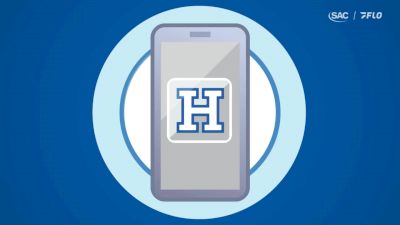 Replay: Lander vs Mars Hill | Mar 28 @ 6 PM
Replay: Lander vs Mars Hill | Mar 28 @ 6 PMMar 29, 2024
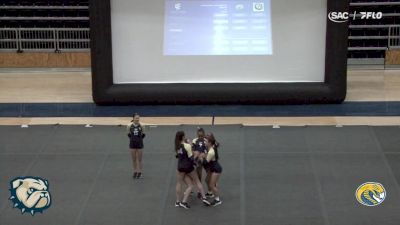 Replay: Coker vs Wingate | Mar 21 @ 6 PM
Replay: Coker vs Wingate | Mar 21 @ 6 PMMar 22, 2024
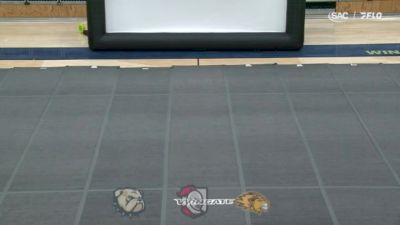 Replay: Wingate Tri-Meet - Acrobatics & Tumbling | Mar 15 @ 5 PM
Replay: Wingate Tri-Meet - Acrobatics & Tumbling | Mar 15 @ 5 PMMar 15, 2024
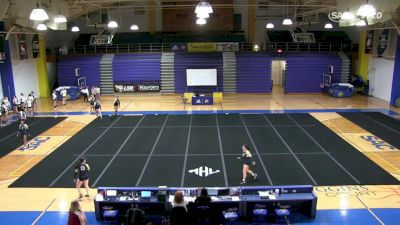 Replay: Mars Hill Tri-Meet | Feb 16 @ 6 PM
Replay: Mars Hill Tri-Meet | Feb 16 @ 6 PMFeb 17, 2024
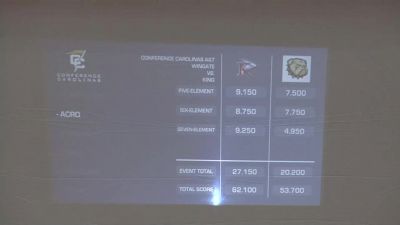 Replay: King (TN) vs Wingate - 2024 2024 King (TN) vs Wingate - Acrobatics & Tumbling | Feb 10 @ 4 PM
Replay: King (TN) vs Wingate - 2024 2024 King (TN) vs Wingate - Acrobatics & Tumbling | Feb 10 @ 4 PMFeb 10, 2024
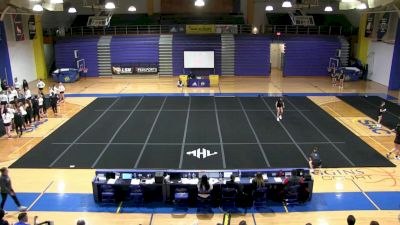 Replay: Belmont Abbey vs Mars Hill | Feb 10 @ 3 PM
Replay: Belmont Abbey vs Mars Hill | Feb 10 @ 3 PMFeb 10, 2024
 How to Watch: 2024 King (TN) vs Wingate - Acrobatics & Tumbling | Gymnastics
How to Watch: 2024 King (TN) vs Wingate - Acrobatics & Tumbling | GymnasticsFeb 10, 2024
 How to Watch: 2024 Wingate Tri-Meet | Gymnastics
How to Watch: 2024 Wingate Tri-Meet | GymnasticsFeb 8, 2024
 How to Watch: 2024 Wingate Tri-Meet | Gymnastics
How to Watch: 2024 Wingate Tri-Meet | GymnasticsFeb 8, 2024
